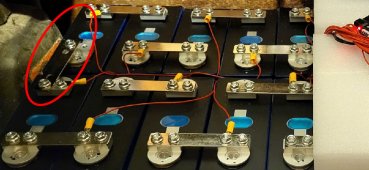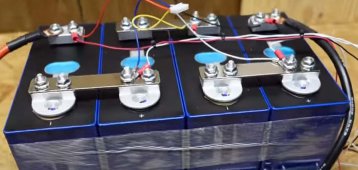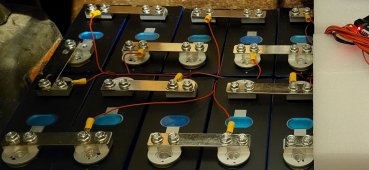If you clean battery aluminum terminal surface to remove aluminum oxide build up, the measurements stated below were made with normal single post EVA cells with raw aluminum terminal flats.
These double post terminals need to be checked to see if they are a 'COALR-like' plated surface and not just bare aluminum. Their dull appearance makes me think they are cad plated, like electrical panel box connection terminals compatible with aluminum or copper wire. This would give their surface a slightly higher resistance than clean bare aluminum but would not suffer aluminum oxide build up, giving them a more user-friendly consistent surface to surface contact resistance without significant cleaning.
Based on a quantity of about 75 single post EVA cell bare aluminum terminal connection with high current four point resistance measurements, the basis series resistance for a good clean nickel plated bus bar average was:
- Single post/nut only component of cell terminal flat to bus bar surface series resistance = 0.05 milliohm on average. If surface of a bare aluminum battery terminal flat is not cleaned of aluminum oxide first, the resistance is highly variable and can easily be upwards of over 0.15 milliohm each.
- A nickel plated copper core bus bar of 2 mm thickness, 20 mm width, and 72 mm hole to hole spacing has a series resistance of 0.04 milliohms on average.
If you have a cheap brass core bus bar, their bus bar only piece of series resistance for same dimensions is 0.17 milliohms on average compared to 0.04 milliohm for nickel plated copper core bus bar.
For an old bare aluminum terminal EVA cell with single post, the two-cell terminal-to-terminal connection resistance is 0.05 mohm + 0.04 mohm + 0.05 mohm = 0.14 milliohm on average for copper core bus bars. That is about 7 mV drop between cell terminals for 50 amp inverter current.
With double posts, you can assume the net terminal post to bus bar surface contact resistance would drop by about half from 0.05 milliohm to 0.025 milliohm.
That would yield 0.025 + 0.04 + 0.025 = 0.09 milliohm cell terminal to cell terminal series resistance. About 5 mV drop between cell terminals at 50 amp inverter current. Again, this may be slightly higher if the double post has a COALR-like plated surface.
 Issue comes in on the picture's middle left side bus bar connection
Issue comes in on the picture's middle left side bus bar connection. It has a slightly longer distance than 72 mm's, it lacks the double post connections, and more importantly, there are two empty holes drilled in bus bar between connections that will significantly increase bus bar resistance. At 50 amps of inverter current, I would expect about 15-18 mV drop between these two battery terminals versus about 4-6 mV drop across other double post bus bars. The minimum thing to do is get a regular single hole pair bus bar to replace the four holed bus bar. That would get 50-amp voltage drop to about 8-12 mV, not great, but better.
For moderate inverter load current, the picture's middle left side bus bar connection will cause higher cell voltage reading on BMS for the upper right hand corner cell due to the extra resistance in that particular bus bar's voltage sense wire connection points. This can screw up BMS balancing when there is variable amount of charging current or inverter discharge current when balancing voltage sensing is happening.





